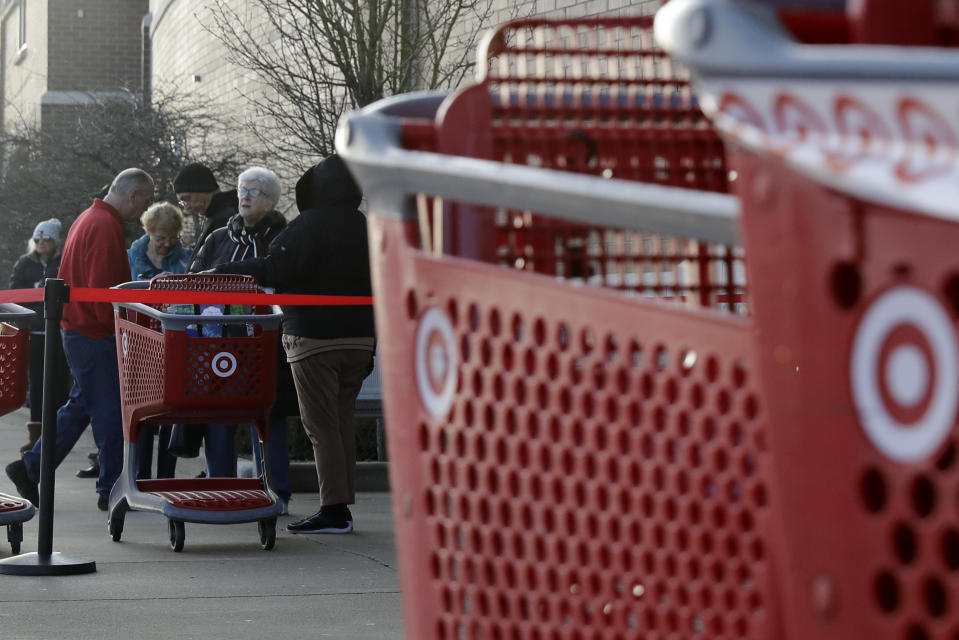Target's bottom line fueled by people spending during the coronavirus
One wild, wild quarter for Target (TGT) has come to an end on a rather upbeat note.
Target Chairman and CEO Brian Cornell told reporters on a call that the last few weeks of the first quarter ending May 2 were strong across many departments, fueled in part by shoppers spending during the novel coronavirus outbreak. The late quarter sales surge — similar to what Walmart executives shouted out on their earnings call on Tuesday — helped power Target’s bottom line well past Wall Street estimates.
Despite the sales momentum, Target declined to provide second quarter or full-year guidance. The company yanked its full-year guidance back in March citing volatile trends in the business weekly.
Here is how Target performed in the first quarter, compared to Wall Street’s expectations:
Net Sales: $19.6 billion vs. estimates for $18.75 billion
Operating Income: $468 million vs. estimates for $387.1 million
Adjusted Diluted EPS: 59 cents vs. estimates for 46 cents
And here are the positives and negatives of the quarter, as assessed by Yahoo Finance.
Positives:
Target’s comparable sales up 10.8% versus Walmart U.S. comp sales up 10%.
Target’s digital comparable sales up 141% versus Walmart U.S. e-commerce sales up 74%.
Inventory declined 5.5%.
Negatives:
Operating margins fell to 2.4% from 6.4% a year ago on a combination of (1) more sales of lower margin products such as food; (2) weak sales of higher margin apparel; and (3) investments in “premium pay” for hourly workers and new safety measures in stores.

After some shocking intra-quarter business updates (both good, and not so good) from Target, it’s likely the Street will view the quarter initially as positive.
Chief among the reasons why is that there appears to be a sense of stability and consistency forming in Target’s business as states start to reopen after being under quarantine and stimulus checks are spent. Another factor here is that Target — right along with Walmart and Costco — are proving themselves to be the biggest winners right now in retail. Not only have all three pivoted to accommodate consumers to meet their new shopping needs (cleaner stores, curbside pickup, etc.), but have they have the balance sheets to continue to invest in the future of consumption.
The likes of J.C. Penney, Macy’s, Neiman Marcus, J. Crew and countless other retailers can’t say the same thing at the moment.
Video note: Target has not yet decided on whether it will make its $2 an hour increase (put in effect to support new efforts by workers amidst the pandemic) in wages for store workers permanent. Cornell told Yahoo Finance on a media call Tuesday evening about the wages, “We talk about that a lot, we feel great about the investment we’ve made in our team and we’ll continue to evaluate the environment, the needs of our teams, the needs of our guests on a week-by-week basis.”
Brian Sozzi is an editor-at-large and co-anchor of The First Trade at Yahoo Finance. Follow Sozzi on Twitter @BrianSozzi and on LinkedIn.
Read the latest financial and business news from Yahoo Finance
Levi's reports solid quarterly earnings, CEO says jeans maker will come out of coronavirus stronger
Yum! Brands CEO on how his 50,000 restaurants are doing amidst the coronavirus pandemic
Grubhub founder: our sign-ups are surging during the coronavirus
HP CEO: here’s how we are helping coronavirus relief efforts
Follow Yahoo Finance on Twitter, Facebook, Instagram, Flipboard, SmartNews, LinkedIn, YouTube, and reddit.
